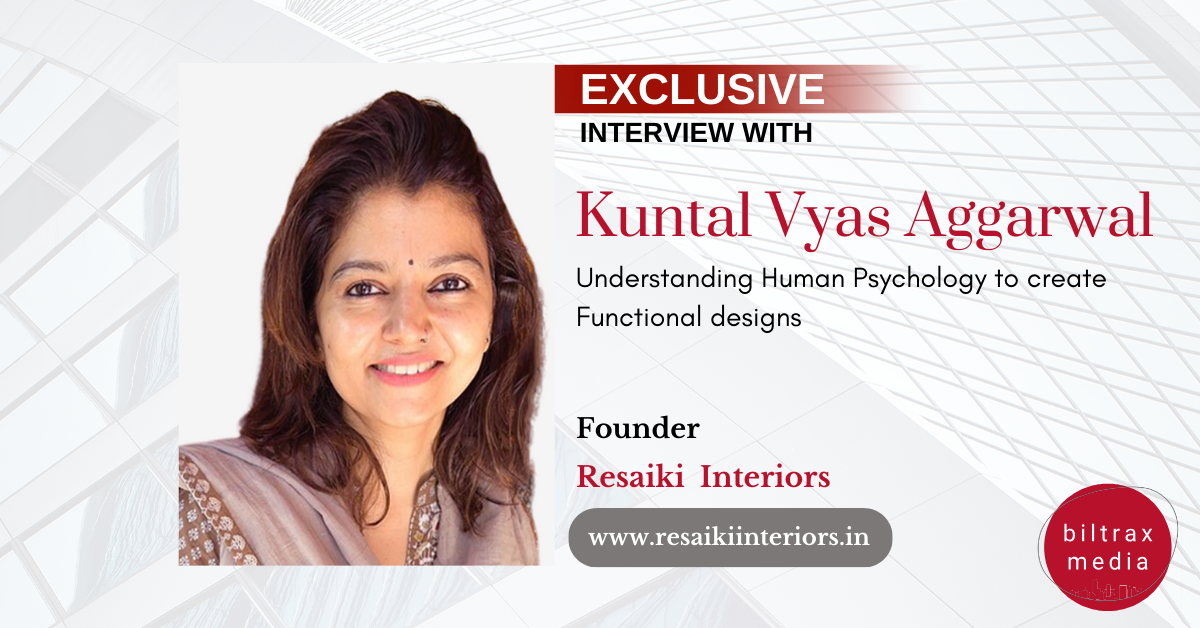In this insightful interview conducted by Biltrax Media, we delve into the intersection of human psychology and functional design with Mrs. Kuntal Vyas Aggarwal, the founder of Resaiki—a prominent architecture and interior design firm based in Noida. Exploring the intricate relationship between design and human behavior, Aggarwal unveils the secrets behind crafting spaces that not only captivate the eye but, more importantly, resonate with the intricate nuances of the human mind. She eloquently unravels the symbiotic relationship between form and function, guiding us through the corridors of spatial design that extend beyond mere pixels and lines. As we navigate through the interview, the fusion of psychological perspectives and design concepts unfolds, shedding light on the profound impact thoughtful design can have on individuals and communities alike.
Crafting Spaces: A Journey into the Psychology of Functional Interior Designs
As a designer, I constantly explore the intricate web of human psychology, seeking the secrets behind creating truly functional spatial designs. It’s more than just pixels and lines; it’s about understanding the minds that interact with our designs. In the dynamic world of interior design, my compass is guided by the principles of aesthetics and the intricate map of human psychology. This journey explores how understanding the nuances of the human mind can shape functional interior designs that seamlessly blend form and purpose.
This marriage of functionality and aesthetics transcends the union of colors and furniture; it’s a dance with the psyche of those who inhabit the spaces we create. For instance, understanding how humans navigate and perceive space informs the placement of furniture and the flow of a room, creating an unspoken dialogue between the design and the occupant for harmony and ease of movement.

Colour, a silent language, plays a pivotal role. Beyond the visual appeal, colours evoke emotions and influence moods. Orchestrating a symphony of colours resonates with occupants, fostering an aesthetically pleasing and emotionally comforting environment. Different colours evoke distinct emotional responses; understanding these nuances empowers designers to select colours that resonate with the desired user experience. The thoughtful use of colour and lighting significantly influences a room’s ambience. Choosing soft, neutral tones creates a peaceful retreat, accommodating diverse decor styles and promoting a relaxed atmosphere. Involving users in the design process allows them to select colours and materials that enhance comfort and safety.

Texture and materials contribute to overall coziness. Prioritizing soft fabrics for furniture and bedding, avoiding discomfort-inducing materials, and minimizing strong odors enhance the tactile experience and create a pleasant living space. Furniture, often considered the soul of a space, is more than design elements; it’s about understanding ergonomics and the psychology of comfort. Placing a cozy chair by the window isn’t just about aesthetics; it’s an invitation to unwind, bask in natural light, and connect with the outside world.

Lighting, a subtle but powerful design tool, orchestrates the mood of a space. Natural light fosters a connection to the external environment. Understanding the psychological impact of lighting allows for creating spaces that adapt to the varying needs of occupants. A well-planned layout and furniture arrangement are essential for functional and comfortable living. Clear, uncluttered spaces reduce sensory overload, while strategic furniture placement enhances flow and accessibility. Designating specific areas as quiet retreats, equipped with comfortable seating and calming elements, provides dedicated spaces for decompression and recharging. Incorporating sensory-friendly items like weighted blankets enhances these retreats.

Effective noise reduction strategies, such as sound-absorbing materials and noise-canceling devices, are crucial for a serene environment. These measures improve acoustics and foster tranquillity, allowing occupants to focus without disruptive noise. Using essential oils with calming scents, aroma therapy places overwhelming smells, creating a pleasant atmosphere. Minimizing visual clutter by organizing and decluttering creates a streamlined and visually appealing environment, promoting order and calmness.
As a designer, my canvas extends beyond the physical to the emotional—creating a narrative within four walls that responds to the needs, habits, and aspirations of those who call it home. The psychology of interior design is a journey of empathy, where every decision is informed by the desire to enhance the human experience within a space.
Therefore, exploring the potential of functional design is a journey into the intricate workings of the human mind. By grasping the fundamentals of psychology, designers can craft experiences that resonate on a profound level. This involves understanding the user’s subconscious and orchestrating a harmonious dance between form and function. In an era where global awareness of the built environment’s impact on mental and emotional well-being is growing, Vastu emerges as a subtle guide. It gently steers designers and homeowners towards spaces reverberating harmoniously by seamlessly blending ancient wisdom with contemporary design sensibilities. Vastu enriches the interior design narrative, emphasizing that a well-designed space is not just about its visual aesthetics but also about the emotions it stirs within the soul. In conclusion, the spaces we create become integral parts of the human experience—a testament to the artistry of functional interior design.

Biltrax Construction Data is tracking 27,000+ projects on their technology platform for their clients.
Get exclusive access to upcoming projects in India with actionable insights and gain a competitive advantage for your products in the Indian Construction Market.
Visit www.biltrax.com or email us at contact@biltrax.com to become a subscriber and generate leads.
Disclaimer: The information contained herein has been compiled or arrived at, based upon information obtained in good faith from sources believed to be reliable. All such information and opinions can be subject to change. The image featured in this article is for representation purposes only and does not in any way represent the project. If you wish the article to be removed or edited, please email editor@biltrax.com.
Discover more from Biltrax Media, A Biltrax Group venture
Subscribe to get the latest posts sent to your email.






















